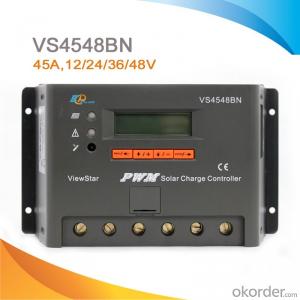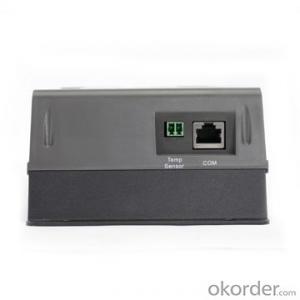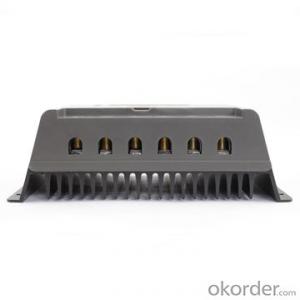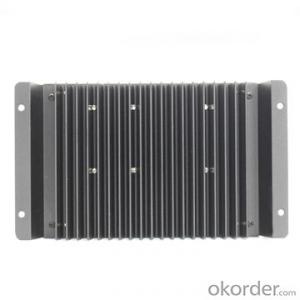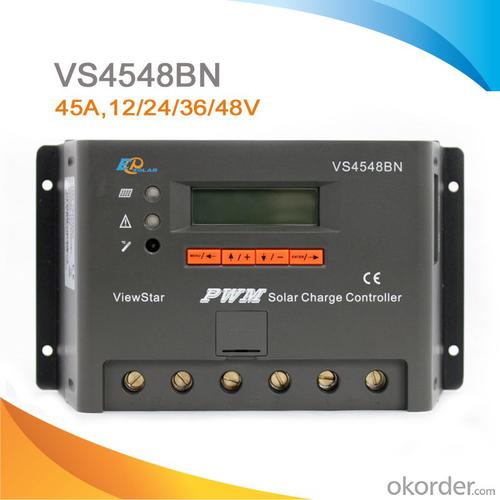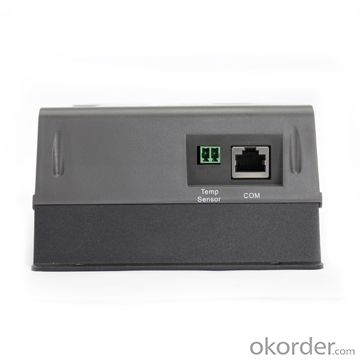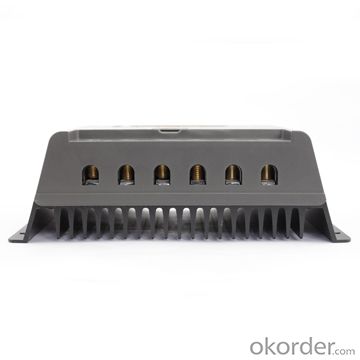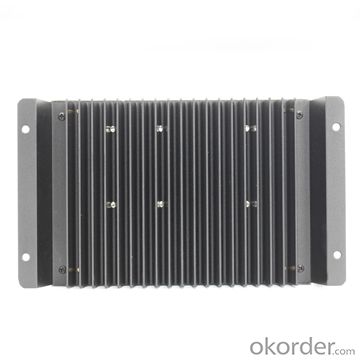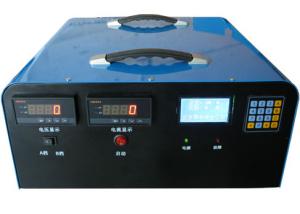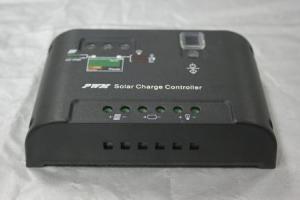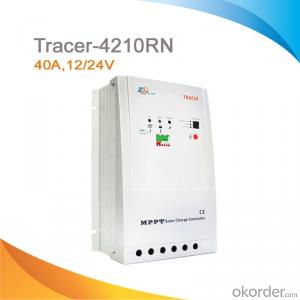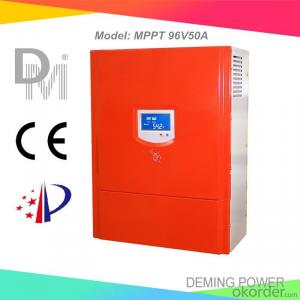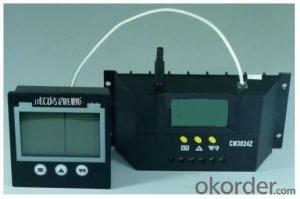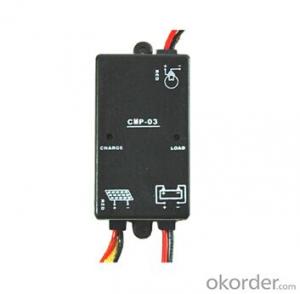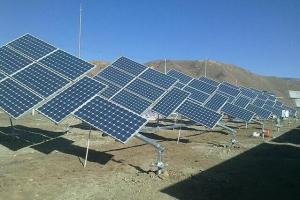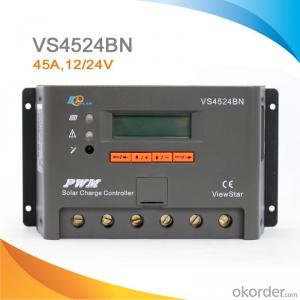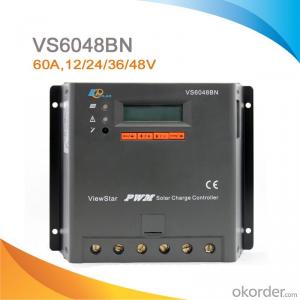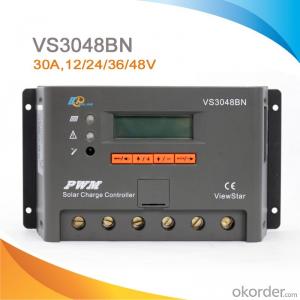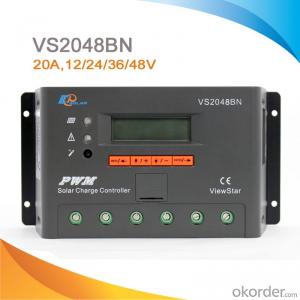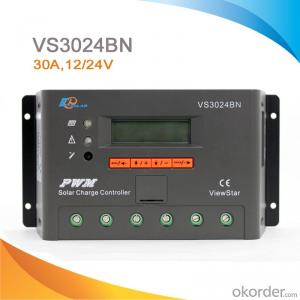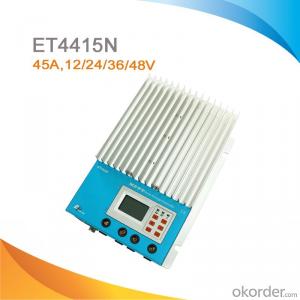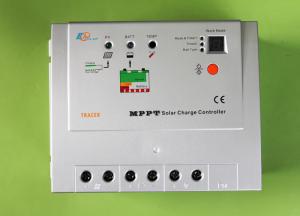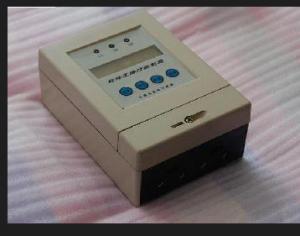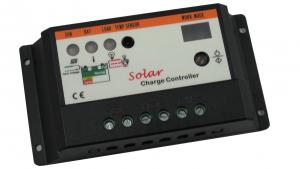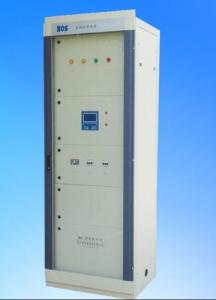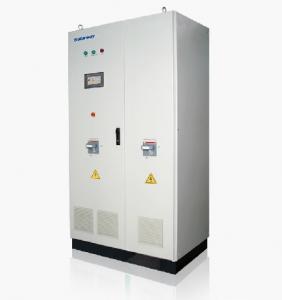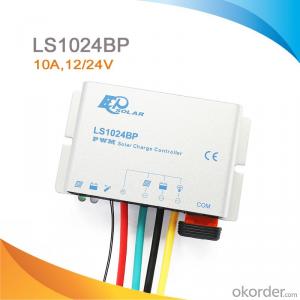North Bay Solar Charge Controllers LCD Display PWM Solar Panel Charge Controller/Regulator 45A 12/24/36/48V, VS4548BN
OKorder Service Pledge
OKorder Financial Service
You Might Also Like
ViewStar series solar controller is our new generation controller for off-grid solar system, such as street light, solar home system or small power station etc.
Features:
·Excellent EMC design
·32 bit MCU with high speed
·High efficient Series PWM charging
·Four battery type options: Sealed, Gel, Flooded, and USER
·Intelligent lighting and timer control for solar lighting system
·12 bit A/D high-precision sampling to ensure accuracy
·Use MOSFET as electronic switch
·Full control parameters setting and modification, diversified load control mode
·Humanized design of browser interface, undertake every operating conveniently
·Temperature compensation
·Adopt graphics dot-matrix LCD screen and HMI (human-machine interface) with 4 buttons,integrated menu displaying and operation
·Energy statistics function
·RS485 ports with MODBUS communication protocol
·Optional PC monitoring software and remote meter for real-time monitoring and battery management parameter setting
·Field upgradable firmware
Electronic Protections:
·PV short circuit protection
·PV reverse polarity protection
·Battery overcharge protection
·Battery over discharge protection
·Battery reverse polarity protection
·Load overload protection
·Load short circuit protection
·Overheating protection
Specification:
Nominal system voltage | 12/24/36/48V auto work | |||
Rated battery current | 20A | 30A | 45A | 60A |
Rated load current | 20A | 30A | 45A | 60A |
Max. battery voltage | 64V | |||
Equalize charging voltage | Sealed: 14.6V, Flooded: 14.8V, User-defined: 9~17V | |||
Boost charging voltage | Gel: 14.2V, Sealed: 14.6V, Flooded: 14.8V, User-defined: 9~17V | |||
Float charging voltage | Gel /Sealed /Flooded: 13.8V, User-defined: 9~17V | |||
Low voltage reconnect voltage | Gel /Sealed /Flooded: 12.6V, User-defined: 9~17V | |||
Low voltage disconnect voltage | Gel /Sealed /Flooded: 11.1V, User-defined: 9~17V | |||
Self-consumption | ≤15mA(12V); ≤10mA(24V); ≤9mA(36V); ≤8mA(48V) | |||
Grounding | Common negative | |||
Temp. compensation | -3mV/°C/2V | |||
Relative humidity | 10%~90% Non-condensation | |||
Communication | RS485 / RJ45 interface | |||
LCD temperature | -20°C ~ +70°C | |||
Working temperature | -25°C ~ +55°C | |||
Humidity | ≤95% N.C. | |||
Enclosure | IP30 | |||
Overall dimension | 200x103x58mm | 201x109x59mm | 205x119x67mm | 205x174x64mm |
Terminals | 16mm2 | 35mm2 | 35mm2 | 35mm2 |
Net weight | 0.7kg | 0.9kg | 1.2kg | 1.5kg |
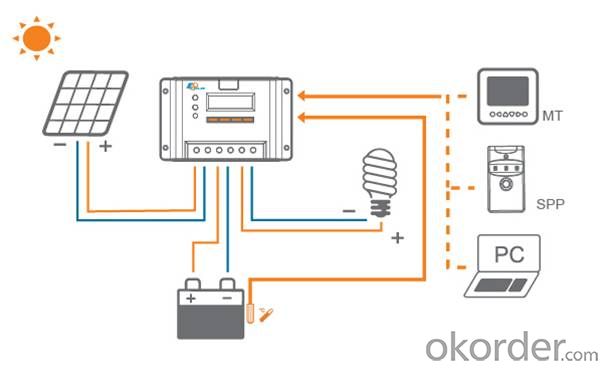
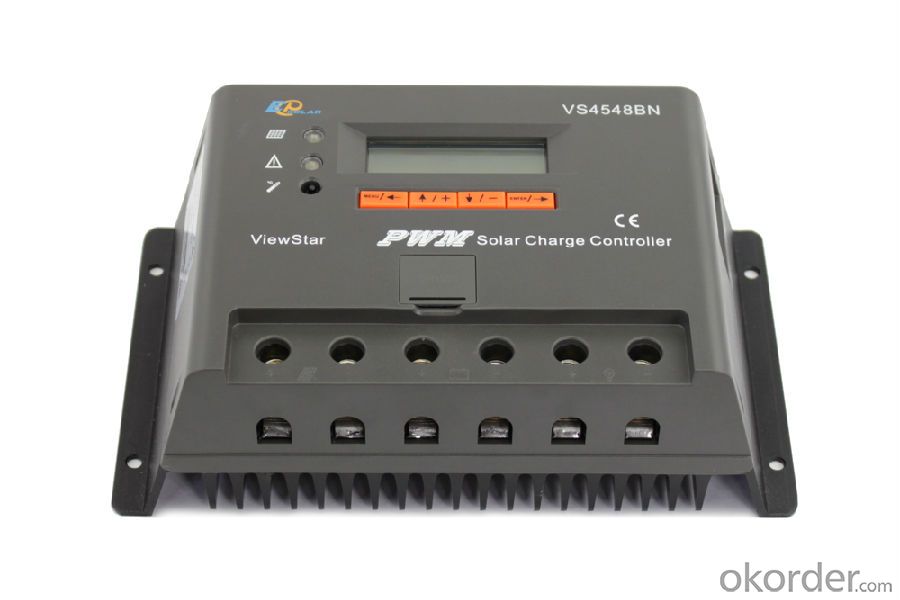
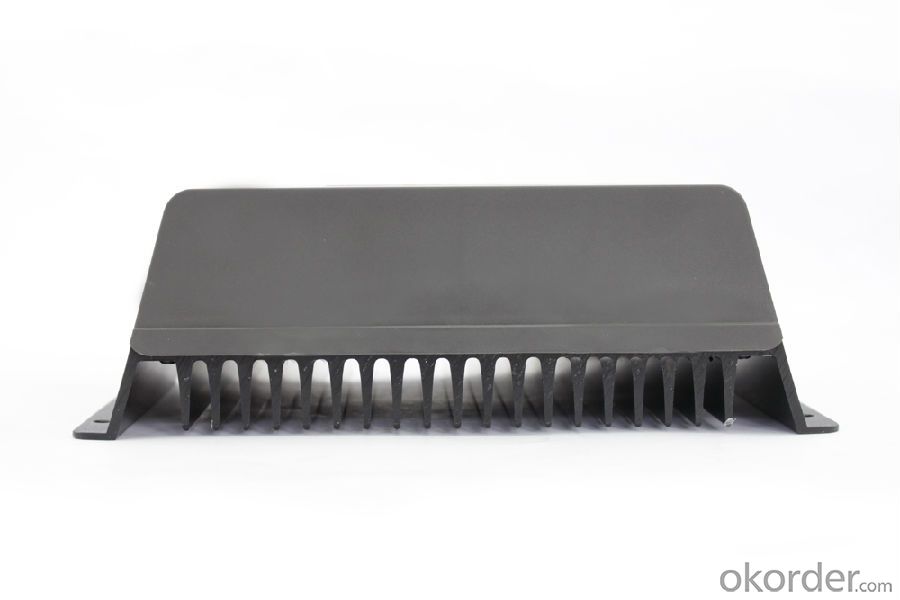

FAQ:
Q1. What is the voltage?
A1. Our 45/60A solar charge controller is 12/24/36/48V auto work.
Q2. What is the difference between MPPT&PWM?
A2. MPPT has higher efficiency, it can track the max power point and won't waste energy.
Q3. What is the efficiency of the MPPT controller?
A3. MPPT>99%, peak conversion efficiency>98%.
Q4. What is the waranty of product?
A4. 12 months.
- Q: How does a solar controller handle voltage drop in the wiring?
- A solar controller handles voltage drop in the wiring by utilizing a built-in circuitry that detects and compensates for the drop in voltage. It adjusts the charging parameters accordingly to ensure the solar panel's output voltage is sufficient to charge the battery effectively, despite the voltage loss in the wiring.
- Q: What is the load current rating of a solar controller?
- The load current rating of a solar controller refers to the maximum amount of current it can safely handle when supplying power to connected loads, such as lights or appliances. The specific rating can vary depending on the model and specifications of the solar controller.
- Q: Can a solar controller be used with a solar-powered wireless communication system?
- Yes, a solar controller can definitely be used with a solar-powered wireless communication system. A solar controller is responsible for regulating the power output from solar panels to ensure efficient charging of batteries and protection against overcharging. In the context of a solar-powered wireless communication system, the solar controller would play a crucial role in managing the power supply to the communication devices. By connecting the solar panels to the solar controller, it can optimize the charging process by adjusting the voltage and current levels according to the battery's needs. This helps to maximize the efficiency of the solar panels and ensure that the batteries are charged properly. Moreover, a solar controller also provides important safety features such as preventing overcharging, which could damage the batteries or the communication system. It can also protect against reverse current flow, which can occur during periods of low sunlight or at night when the solar panels are not producing power. Overall, a solar controller is a crucial component in any solar-powered system, including wireless communication systems. It ensures efficient power management, prolongs the lifespan of batteries, and helps maintain reliable communication in remote or off-grid locations.
- Q: How does a solar controller protect against lightning strikes?
- A solar controller typically includes surge protection devices that help divert the high voltage caused by a lightning strike away from the solar system. These devices act as a pathway for the excess energy to ground, preventing it from damaging the solar panels, inverters, or other components of the system.
- Q: How do I protect a solar controller from lightning strikes?
- To protect a solar controller from lightning strikes, it is recommended to use surge protectors or lightning arresters specifically designed for solar power systems. These devices help divert excessive voltage caused by lightning strikes away from the controller, preventing damage to the equipment. Additionally, grounding the solar system properly and ensuring all electrical connections are secure can further protect the controller from lightning-induced power surges.
- Q: Are there any safety features in solar controllers?
- Yes, there are several safety features in solar controllers. Some common safety features include overcharge protection, over-discharge protection, short-circuit protection, reverse polarity protection, and temperature compensation. These features ensure the safe and efficient operation of solar controllers and help protect the connected batteries and solar panels from damage.
- Q: How does a solar controller prevent overvoltage in the battery?
- A solar controller prevents overvoltage in the battery by monitoring and regulating the charging process. When a solar panel produces electricity, it sends it to the battery for storage. However, if the solar panel generates more voltage than the battery can handle, it can lead to overcharging and damage to the battery. To prevent this, a solar controller acts as a regulator between the solar panel and the battery. It constantly monitors the voltage level of the battery and ensures that it does not exceed a certain predetermined threshold. If the battery voltage approaches or exceeds this threshold, the solar controller will automatically reduce the charging current or disconnect the solar panel from the battery to prevent overvoltage. Solar controllers employ various methods to regulate charging and prevent overvoltage. One common technique is called pulse-width modulation (PWM), where the controller rapidly switches the charging current on and off to maintain a steady voltage level. Another method is called maximum power point tracking (MPPT), which optimizes the output of the solar panel to match the battery's voltage requirements. In addition to preventing overvoltage, solar controllers also perform other important functions like temperature compensation, which adjusts the charging parameters based on the battery's temperature, and low voltage disconnect, which protects the battery from deep discharge. By effectively managing the charging process, solar controllers ensure the longevity and optimal performance of the battery in a solar power system.
- Q: Can a solar controller be used with solar-powered indoor industrial buildings?
- Yes, a solar controller can be used with solar-powered indoor industrial buildings. A solar controller, also known as a charge controller, is an essential component of a solar power system. Its main function is to regulate the voltage and current from the solar panels to ensure efficient charging and prevent overcharging of the batteries. In the case of solar-powered indoor industrial buildings, the solar controller plays a crucial role in managing the flow of electricity generated by the solar panels. It helps optimize the energy production and delivery to power various equipment and systems within the building. The solar controller ensures that the batteries are charged properly and maintains a stable power supply to the indoor industrial building. It also protects the batteries from damage caused by overcharging or excessive discharge, which can extend their lifespan and overall system efficiency. Additionally, a solar controller can provide monitoring and control capabilities, allowing users to track the performance of the solar panels and batteries. This data can be used to optimize energy usage, identify potential issues, and make informed decisions to improve the overall efficiency of the solar-powered indoor industrial building. Overall, a solar controller is an essential component for managing and optimizing solar power systems, making it suitable for use in solar-powered indoor industrial buildings.
- Q: How do you protect a solar controller from lightning strikes?
- To protect a solar controller from lightning strikes, it is important to employ a combination of preventive measures. Firstly, ensure that the solar controller is installed in a grounded location, ideally using a grounding rod that is installed deep into the ground. Additionally, it is recommended to install surge protection devices (SPDs) that are specifically designed to mitigate lightning-induced surges. These SPDs should be installed both at the solar panel array and at the electrical equipment, including the solar controller. Lastly, utilizing proper lightning arrestors and lightning rods in the vicinity of the solar system can divert lightning strikes away, providing an extra layer of protection.
- Q: How does a solar controller prevent short circuits in the solar panel array?
- By monitoring and regulating the flow of electricity from the solar panels to the battery or grid, a solar controller effectively prevents short circuits in a solar panel array. Acting as an intermediary between the panels and the battery, it carefully controls and optimizes the voltage and current levels to ensure safe and efficient operation. Short circuits can occur when an unintended connection or path is formed between the positive and negative terminals of a solar panel. This can happen due to various factors including damaged wiring, faulty connections, or extreme weather conditions. When a short circuit happens, it can result in excessive current flow, overheating, and potential damage to the panels or other system components. To prevent short circuits, a solar controller employs various mechanisms. One important feature is the integration of bypass diodes into the solar panels. These diodes help redirect the current flow around any shaded or malfunctioning cells, effectively preventing them from causing short circuits. By rerouting the current, the solar controller ensures that the overall performance of the array remains largely unaffected. In addition, solar controllers are equipped with overcurrent protection mechanisms such as fuses or circuit breakers. These devices are designed to interrupt the flow of electricity in the event of excessive current, effectively preventing short circuits. They act as safeguards by limiting the maximum current that can be drawn from the solar panels, thus protecting the system from damage. Moreover, solar controllers continuously monitor the voltage and current levels of the solar panels. They regulate the charging process by maintaining the voltage within a safe range, thereby preventing overcharging which can lead to damage to the panels or battery. The controller adjusts the charging parameters based on the battery's state of charge, ensuring that the panels are not overloaded and reducing the risk of short circuits. In conclusion, a solar controller plays a critical role in preventing short circuits in a solar panel array. It achieves this through the incorporation of bypass diodes, overcurrent protection mechanisms, and voltage regulation. By ensuring safe and efficient operation, the solar controller maximizes the lifespan of the system and allows for optimal performance of the panels.
Send your message to us
North Bay Solar Charge Controllers LCD Display PWM Solar Panel Charge Controller/Regulator 45A 12/24/36/48V, VS4548BN
OKorder Service Pledge
OKorder Financial Service
Similar products
Hot products
Hot Searches
Related keywords
